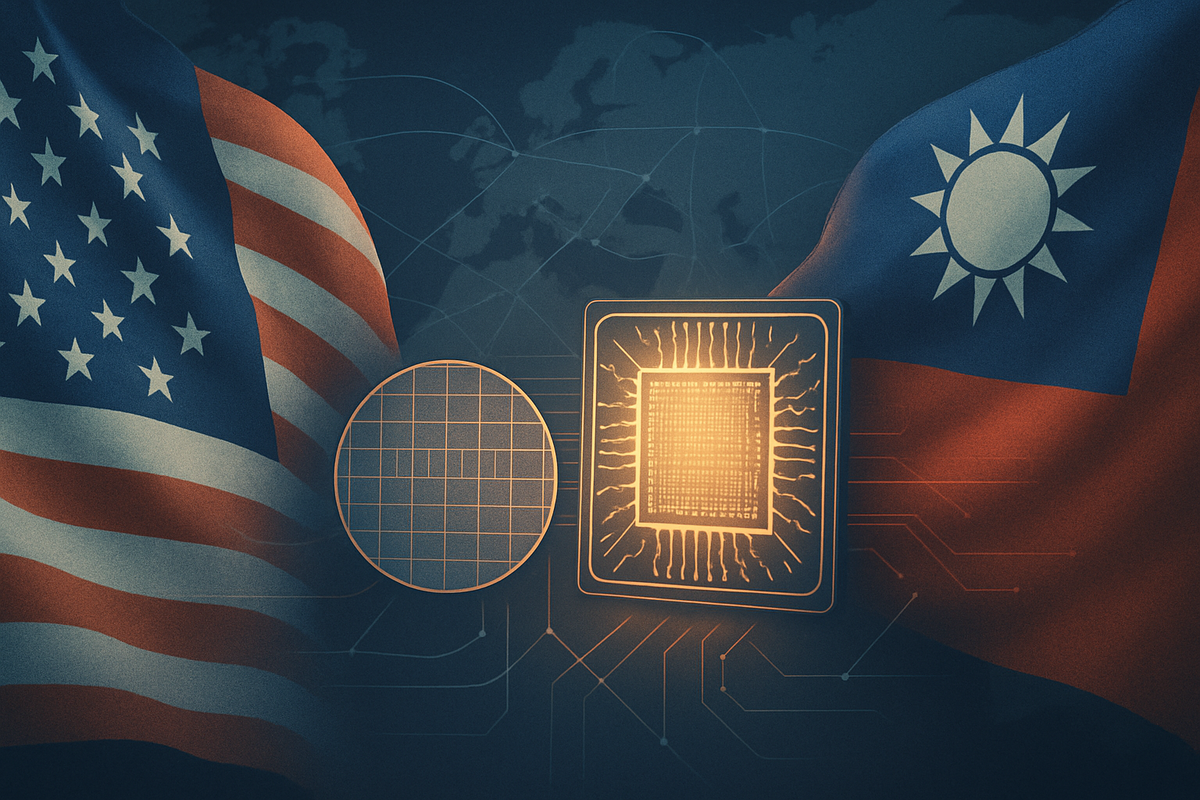
Taipei's unequivocal rejection of a United States proposal to split semiconductor production evenly, with half of the chips consumed by the US manufactured on American soil, marks a critical juncture in the increasingly fraught global chip landscape. This firm denial, announced by Taiwan's Vice Premier Cheng Li-chiun on October 1, 2025, underscores a deep-seated strategic divergence between the two allies and has immediate implications for ongoing trade negotiations, the future of the "silicon shield," and the operational strategies of industry giants like Taiwan Semiconductor Manufacturing Company (TSMC).
The refusal highlights Taiwan's determination to maintain its strategic control over its leading chip industry, viewing it as a vital national security asset. This stance sets the stage for potential tensions in US-Taiwan relations, as Washington aggressively pursues supply chain resilience, while Taipei guards its technological dominance. The decision also casts a long shadow over the future of global chip dynamics, challenging the US's ambitious goal of greater domestic production and potentially reshaping the highly interconnected semiconductor ecosystem.
Taiwan Stands Firm Against US Chip Production Demands
The core of the dispute centers on a proposal reportedly put forth by US Commerce Secretary Howard Lutnick, suggesting a 50/50 split in semiconductor production for the American market. However, Taiwan's Vice Premier Cheng Li-chiun, fresh from trade talks in Washington, publicly refuted any such agreement, stating emphatically, "I want to clarify that this is the US's idea. Our negotiation team has never made a 50-50 commitment to a chip split." She further assured the Taiwanese public that the issue was not discussed during the recent round of talks and that Taiwan "will not agree to such a condition."
This rejection comes amidst a complex and escalating timeline of events. Prior to October 1, 2025, Secretary Lutnick had publicly floated the idea of the 50/50 split. In July 2025, the US had already implemented a temporary 20% reciprocal tariff on certain Taiwanese exports, though semiconductor-related goods were initially exempted pending a Section 232 review. The pressure intensified in early August 2025, when US President Donald Trump reportedly threatened "fairly substantial tariffs," potentially as high as 100% to 300%, on semiconductors entering the US if Taiwan did not significantly relocate its advanced manufacturing to American soil. Around the same time, the US government acquired a 10% equity stake in Intel (NASDAQ: INTC), signaling its commitment to bolstering domestic chip production.
Key players in this geopolitical chess match include high-ranking officials from both governments. On the Taiwanese side, Vice Premier Cheng Li-chiun led the charge in rejecting the proposal, with support from Premier Cho Jung-tai and President Lai Ching-te, who have been actively involved in trade discussions. Economic Minister J.W. Kuo has also indicated Taiwan's refusal of any US equity bid in TSMC if it doesn't offer a direct benefit to the island. From the US, Commerce Secretary Howard Lutnick is attributed with the initial 50/50 proposal, while President Donald Trump has been a vocal proponent of domestic manufacturing and has wielded tariff threats. At the heart of the industry is Taiwan Semiconductor Manufacturing Company (TWSE: 2330, NYSE: TSM), the world's largest contract chipmaker, whose operations are central to both Taiwan's strategic leverage and global supply chains. Beyond government and corporate entities, the Taiwanese Parliament and public largely support keeping chipmaking at home, viewing it as crucial for national security, with opposition parties condemning the US proposal as "exploitation and plunder."
Initial market reactions to the broader context of US pressure have already been observed. News in August 2025 of a potential US equity stake in TSMC reportedly led to a tumble in TSMC shares and a nearly 2.5% decline in the broader Taipei market. While specific immediate reactions to the October 1st rejection itself are still unfolding, the ongoing uncertainty surrounding tariffs and production relocation is expected to contribute to continued market volatility, as investors weigh geopolitical risks against the semiconductor industry's robust demand.
Corporate Fortunes in Flux: Winners and Losers in the Chip Standoff
Taiwan's decisive rejection of the US 50/50 chip production proposal sends ripples through the boardrooms of the world's leading semiconductor companies, solidifying existing strategies for some while creating new challenges and opportunities for others. The immediate and long-term implications will be particularly felt by Taiwan Semiconductor Manufacturing Company (TWSE: 2330, NYSE: TSM), as well as major US players like Intel and Micron, and global giants such as Samsung and ASML.
For Taiwan Semiconductor Manufacturing Company (TWSE: 2330, NYSE: TSM), Taiwan's stance is a double-edged sword. On one hand, it allows TSMC to largely maintain its dominant position in advanced chip manufacturing within Taiwan, preserving the island's crucial "silicon shield" and TSMC's global technological leadership. This ensures that the core of its cutting-edge research and development, along with the vast majority of its production capacity, remains rooted in its highly efficient domestic ecosystem. However, TSMC is still committed to substantial investments in the US, notably over $165 billion for multiple fabrication plants in Arizona, partly incentivized by $6.6 billion in US CHIPS Act funding. These US facilities, while strategically important for diversification, face significant operational challenges, including estimated production costs around 50% higher than in Taiwan, regulatory hurdles, labor shortages, and supply chain complexities, which have already led to construction delays. Taiwan's leverage, stemming from TSMC's indispensable role, will also be crucial in ongoing tariff negotiations, as the island seeks to mitigate the impact of potential US levies, including a threatened 100% tariff on imported semiconductors.
Meanwhile, US semiconductor companies stand to see the strategic importance of the CHIPS and Science Act significantly reinforced. Taiwan's rejection underscores the US's imperative to boost domestic manufacturing, providing further impetus for the legislation. Intel (NASDAQ: INTC), as the only US firm with advanced semiconductor manufacturing capabilities and an ambition to become the world's second-largest foundry, is a prime beneficiary. With up to $8.5 billion in CHIPS Act subsidies, Intel is investing heavily in new fabs in Ohio and other states. Taiwan's firm stance could indirectly strengthen the political and economic rationale for even greater support for Intel's domestic efforts. Similarly, Micron Technology (NASDAQ: MU) is expanding its production within the US, backed by CHIPS Act funding, aiming to secure a more robust and localized supply chain. While these companies benefit from the domestic push, they could face initial cost increases if broad US tariffs are imposed on imported chips, given their continued reliance on foreign components during the transition to increased domestic production. The US government is also exploring direct equity stakes in domestic chipmakers, signaling a more direct intervention to ensure reshoring success.
Globally, Samsung (KRX: 005930, OTC: SSNLF) of South Korea is also a significant player in the US reshoring movement, investing substantially in US chip manufacturing, particularly in Texas, and receiving up to $6.4 billion under the CHIPS Act. However, Samsung has faced its own set of challenges, including delays in completing its Texas facility and securing sufficient customers for its output. Taiwan's decision means that the core of advanced manufacturing remains largely in Asia, posing a competitive challenge for new US fabs to quickly gain market share if cost-effectiveness is a primary concern. Like TSMC, Samsung, with its substantial production outside the US, would also be susceptible to potential US tariffs on imported semiconductors. ASML (AMS: ASML, NASDAQ: ASML), the Dutch giant and sole producer of extreme ultraviolet (EUV) lithography machines, remains indispensable. Regardless of where advanced chips are produced, foundries like TSMC, Intel, and Samsung will continue to rely on ASML's cutting-edge equipment. The US CHIPS Act's push for domestic manufacturing indirectly supports ASML by creating demand for its sophisticated tools within the US, though delays in new fab construction could temporarily affect equipment sales. The concentration of this critical technology in ASML further amplifies global concerns about supply chain security, and Taiwan's continued strong domestic manufacturing base ensures a sustained high demand for ASML's most advanced tools on the island.
The Shifting Tides of Global Techno-Nationalism
Taiwan's rejection of the US 50/50 chip production proposal is more than a diplomatic spat; it is a profound indicator of shifting geopolitical currents and the deepening embrace of "techno-nationalism" across the globe. This decision underscores Taiwan's unwavering commitment to its "silicon shield" strategy, which leverages its unparalleled dominance in advanced semiconductor manufacturing, primarily through TSMC, as a critical deterrent against external threats and a cornerstone of its national security. With TSMC (TWSE: 2330, NYSE: TSM) accounting for over 90% of the world's advanced chip capacity, Taiwan wields immense strategic leverage, making its chip policy central to the broader US-China technology rivalry.
This event fits squarely into the burgeoning trend of semiconductor supply chain diversification, driven by the vulnerabilities exposed during the COVID-19 pandemic and escalating geopolitical tensions. Nations worldwide are now engaged in a "global subsidy race" to onshore critical chip production. The US CHIPS and Science Act, with its $52.7 billion allocation, aims to significantly boost domestic manufacturing, targeting 28% of global capital expenditures in wafer fabrication by 2032. Similarly, the European Chips Act plans to mobilize over $46.5 billion to double the EU's market share to 20% by 2030. Japan is actively revitalizing its industry, and China continues its "Made in China 2025" drive for self-sufficiency, while India has launched a $10 billion incentive program. These efforts collectively aim to decentralize a supply chain that has, for decades, efficiently concentrated in East Asia, creating a more geographically diverse, albeit potentially more costly, production footprint.
The ripple effects of Taiwan's firm stance are far-reaching. While TSMC continues its substantial overseas investments, the decision ensures the bulk of its advanced production, R&D, and leadership remains in Taiwan, preserving its strategic leverage. For US competitors like Intel (NASDAQ: INTC), TSMC's continued advanced dominance, even with some foreign expansion, presents an ongoing challenge in the race for technological parity. Conversely, Chinese competitors are accelerating their drive for semiconductor self-sufficiency, particularly in mature nodes, which could lead to increased competition and price pressure on TSMC in the long term, with Chinese foundries projected to surpass Taiwan's global mature node manufacturing capacity by 2027. Global equipment suppliers and designers, such as NVIDIA (NASDAQ: NVDA), ASML (AMS: ASML, NASDAQ: ASML), KLA Corporation (NASDAQ: KLAC), and Lam Research Corporation (NASDAQ: LRCX), will continue to see robust demand as TSMC and other foundries scale up, but any tariffs or reduced subsidies on TSMC could increase overall chip costs, affecting industries worldwide.
Regulatory and policy implications are profound, characterized by a departure from traditional liberal trade policies towards state-driven industrial strategies. Beyond the CHIPS Act, US policies include export controls like the Foreign Direct Product Rule, which indirectly gives the US leverage over Taiwanese firms by limiting China's access to advanced capabilities. The ongoing Section 232 investigation into semiconductor imports, with its threats of substantial tariffs, further highlights this assertive regulatory environment. This era of "techno-nationalism" prioritizes domestic semiconductor industries for national security and economic competitiveness, involving massive subsidies, investment screenings, and export controls. While aiming for supply chain resilience, these regulations risk disrupting global collaboration, increasing costs, and potentially slowing innovation, potentially leading to regionalized "sovereign AI" ecosystems. Historically, this mirrors the 1980s US-Japan semiconductor competition, where the US actively intervened to counter Japan's growing influence, marking a resurgence of state-led industrial policy in a critical technology sector.
The Road Ahead: Navigating a Fragmented Future
Taiwan's rejection of the US 50/50 chip production proposal sets the stage for a period of intense recalibration in global semiconductor dynamics, with both short-term pressures and long-term structural shifts on the horizon. The US will likely continue to exert pressure on Taiwan to increase domestic production and relocate a portion of advanced manufacturing, even as Taiwan Semiconductor Manufacturing Company (TWSE: 2330, NYSE: TSM) proceeds with its significant $165 billion investment in Arizona fabs, albeit with the majority of its most advanced production remaining on the island. This delicate balance will define US-Taiwan semiconductor relations, requiring Washington to balance its desire for supply chain resilience with Taipei's determination to maintain its "silicon shield."
For TSMC and other leading chipmakers, strategic pivots are already underway and will intensify. TSMC is actively pursuing global diversification, investing heavily in overseas fabrication facilities in Japan, and exploring potential sites in the UAE and Germany, in addition to its Arizona expansion. This strategy aims to mitigate geographical concentration risks, but comes at a significant cost, with higher operating expenses in overseas facilities (Arizona fabs are estimated to be 5% to 20% more expensive). These rising costs are translating into unprecedented price hikes for TSMC's advanced logic chips, effectively positioning its customers as co-investors in its diversification strategy. Balancing the demands for onshore production with the imperative to safeguard its "silicon shield" by keeping its most advanced manufacturing processes in Taiwan will be TSMC's central challenge. Furthermore, the industry as a whole, particularly in Taiwan, faces a critical and growing shortage of skilled talent, especially in AI and advanced packaging, necessitating proactive measures from both government and industry to cultivate a future workforce.
The market opportunities, driven by soaring demand for advanced chips in AI, augmented/virtual reality, smartphones, and autonomous vehicles, remain robust. The US CHIPS Act provides substantial investment and incentives, fostering growth for companies establishing or expanding operations in the United States, while emerging regional markets, such as the Middle East, are actively pursuing AI infrastructure, offering new avenues for advanced chip supply. However, these opportunities are shadowed by significant challenges. Geopolitical volatility, particularly the escalating US-China-Taiwan tech rivalry, introduces profound uncertainties. The high manufacturing costs associated with new fabs and overseas operations will lead to higher chip prices, ending an era of predictably declining transistor costs. Trade tensions, US export restrictions on advanced chips to China, and the looming threat of further tariffs add layers of complexity and risk, while natural disasters like earthquakes and typhoons pose inherent threats to Taiwan's concentrated infrastructure.
Looking ahead, the global chip supply chain is poised to evolve into a more multipolar structure. While Taiwan will undeniably retain its lead in advanced processes, China's rapid ascent in indigenous semiconductor production, coupled with efforts by other nations to develop local chip manufacturing, will reshape market dynamics. This diversification aims to build greater resilience against future supply chain disruptions, but at the cost of higher chip prices. Geopolitical fragmentation could lead to distinct, more localized supply chain ecosystems, exemplified by TSMC's potential "gigafab" in the UAE serving Middle Eastern AI demand. Despite these global shifts, Taiwan's highly efficient and integrated ecosystem ensures its enduring criticality; completely replicating its chipmaking capabilities would be a multi-year, immense resource endeavor. The most severe, albeit hopefully avoidable, risk remains a military conflict involving Taiwan, which could lead to a complete disruption of the semiconductor industry for a year or more, triggering immediate and widespread global economic repercussions and profoundly impacting US national security.
Wrap-Up: A New Era of Strategic Autonomy and Global Realignments
Taiwan's decisive rejection of the US 50/50 chip production proposal is a landmark moment, fundamentally reaffirming the island's strategic autonomy over its most vital industry. The core takeaway is Taiwan's unwavering commitment to its "silicon shield" – the conviction that its unparalleled dominance in advanced semiconductor manufacturing, primarily through Taiwan Semiconductor Manufacturing Company (TWSE: 2330, NYSE: TSM), is its ultimate guarantor of national security and economic leverage. This rejection was rooted not only in the absence of any prior agreement but also in profound concerns about the economic costs, industrial weakening, and potential erosion of its R&D leadership that a significant production shift would entail. From the US perspective, the proposal reflected a pressing need to reduce dependency on a single, geopolitically sensitive region for critical chips, driven by national security and supply chain resilience imperatives.
Moving forward, the semiconductor market will be defined by a persistent tension between national security interests and the traditional pursuit of globalized supply chain efficiencies. The US will undoubtedly continue its vigorous reshoring efforts through the CHIPS Act, even without Taiwan's explicit agreement to a 50/50 split, potentially leveraging tariffs as a negotiation tool. TSMC, for its part, will pursue a calculated expansion, investing significantly in US facilities while meticulously ensuring that the bulk of its most advanced production capacity, R&D, and leadership remains firmly in Taiwan. This delicate balance will continue to shape US-Taiwan relations, where cooperation on security and supply chain stability must coexist with Taiwan's determination to safeguard its technological supremacy. This dynamic is set to drive a broader restructuring of global supply chains, with other Asian chipmakers like Samsung (KRX: 005930, OTC: SSNLF) also diversifying their manufacturing footprints to enhance resilience.
The lasting impact of this decision is profound. It unequivocally reinforces the "silicon shield" concept, demonstrating Taiwan's resolve not to cede its technological crown jewel despite considerable US pressure. This will undoubtedly lead to a more complex bilateral relationship, where trade and tariff negotiations will be intertwined with broader security and industrial policy discussions. Any disruption to Taiwan's chip production, whether from geopolitical tensions or policy disagreements, poses a severe threat to global economic stability, impacting industries from consumer electronics to defense and artificial intelligence. The situation underscores the urgent need for more formal, inter-governmental agreements between the US and Taiwan concerning semiconductors, moving beyond ad-hoc arrangements to ensure long-term strategic stability in this critical sector.
For investors, the coming months demand vigilance. Closely monitor the progress of US-Taiwan tariff negotiations, as their outcomes could significantly affect costs and market access for Taiwanese manufacturers. Geopolitical developments in the Indo-Pacific, particularly any escalation of tensions between the US and China over Taiwan, will introduce significant market volatility. Pay close attention to the specifics of TSMC's US expansion, observing which types of chip production and advanced process nodes are localized versus those strategically retained in Taiwan, as this will indicate the extent of Taiwan's technological retention. Finally, the surging global demand for AI applications remains a crucial driver for TSMC's business, making continued strong growth in AI infrastructure spending a key metric for investors, regardless of production location specifics.
This content is intended for informational purposes only and is not financial advice





